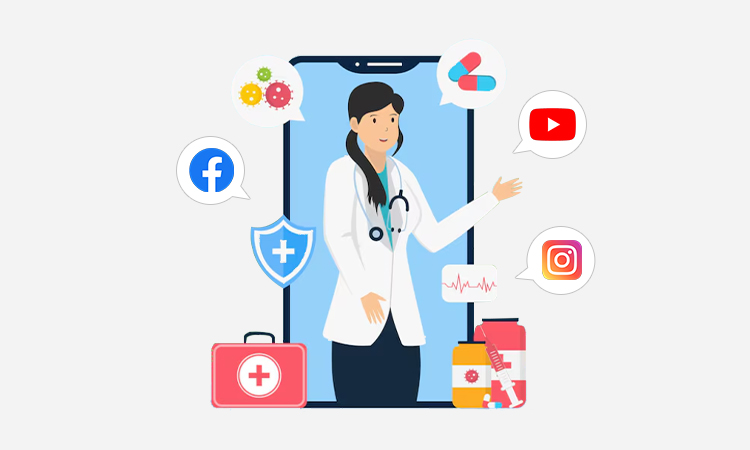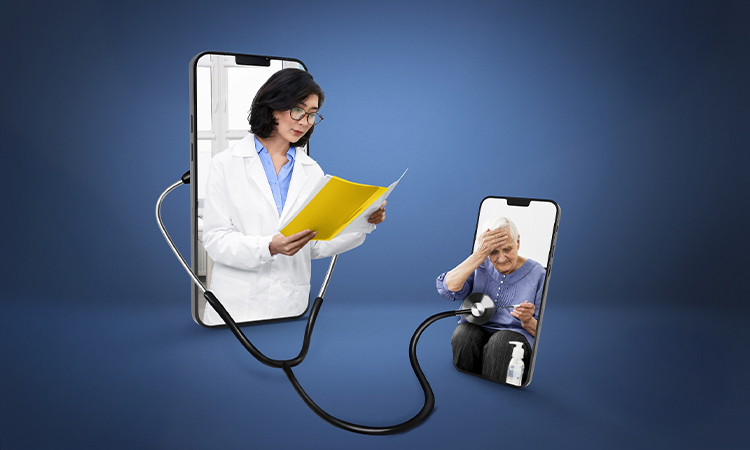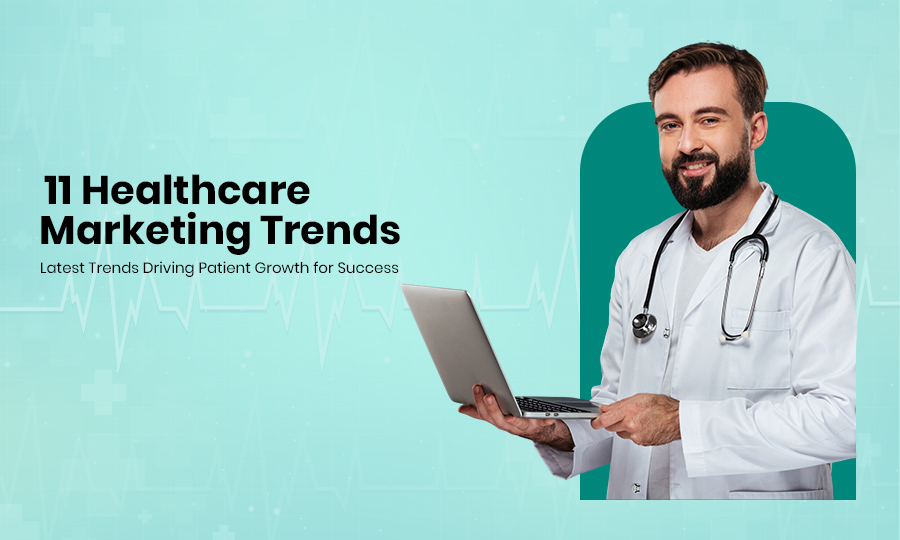Healthcare marketing has changed a lot recently because of new digital ideas and changing patient expectations. The way that medicine communicates with people is changing. In 2025, healthcare providers who learn and follow these healthcare marketing trends will do well in a tough market situation.
Patients are now more aware; they read and search the internet a lot. About 65% of people Google before they see a doctor and more than 60% of people use social media to search for health info. The old way of marketing in healthcare doesn’t work anymore. Doctors and hospitals must utilize data and put the patient first, addressing them where they are in their health journey.
This guide examines the biggest healthcare marketing trends to help grow patients and help practices succeed in 2025. It covers things like the use of artificial intelligence and the increasing use of telehealth. These trends represent opportunities and must-do tasks for healthcare groups looking to improve their marketing techniques.
11 Key Healthcare Marketing Trends to Watch in 2025
In a rapidly changing medical environment, it is crucial that providers keep abreast of healthcare marketing trends in order to communicate effectively with patients and expand their practices. Listed below are 11 key healthcare marketing trends that are currently defining the industry and will continue to determine how patients are acquired, engaged, and retained throughout 2025.
- Rise of AI-Powered Healthcare Marketing
Artificial intelligence is causing the greatest shift in healthcare marketing trends. In 2024, the global AI in healthcare market size was valued at $32.3 billion, and it is anticipated to reach $208.2 billion by 2030, a growth of 524%. This shows that the use of AI is not just good, but it is necessary if hospitals and clinics want to remain competitive.
Today, 79% of healthcare organizations use AI, and for every $1 they spend, they save $3.30. This return is experienced by the majority within 14 months after starting.
Personalized Patient Experiences Using AI
AI can make large-scale patient care feel personal. Most healthcare providers, life science companies and tech vendors use AI in one way or another. They use machine learning to analyze patient data, patient habits, and likes to deliver marketing messages that fit each individual’s needs.
AI helps healthcare marketers to:
- Segment patients according to demographic data, behavioral, and health data → Segment patients by age, gender, income, habits, and health data.
- Predict patient needs with predictive analytics to anticipate care needs→ Guess what patients might need next with data.
- Automate personalized content delivery through multiple channels→ Send personalized messages via email, text, social media, and apps.
- Efficient appointment scheduling with smart online booking systems→ Simplify the appointment process with smart online booking systems.
- Improve patient communication with AI chatbots and virtual assistants→ Chatbots and AI assistants can speak with patients.
Nearly 47% of healthcare organizations are already using or planning to use AI chatbots and virtual assistants. These tools can handle up to 30% of patient interactions, which can reduce administrative work and keep patients happier.
AI in Content Creation and Campaign Optimization
Healthcare marketers are using artificial intelligence increasingly to create content, enhance their campaigns, and analyze performance. AI helps to make marketing plans based on data that fits particular groups of patients, while remaining compliant with HIPAA and maintaining a personal touch that is important in healthcare communication.
But AI can only be used effectively if privacy considerations are made and kept under human control- particularly when dealing with patient health information. Healthcare organizations need to use artificial intelligence with Business Associate Agreements to remain HIPAA compliant.
- Optimized Digital-First Patient Acquisition Tactics
The shift to digital-first marketing in healthcare is evident. The healthcare and pharma industry spends 72.2% of the total media ad expenditure on digital media ads. This shows that patients are shifting the way they seek care, and that digital marketing channels offer a more tangible ROI than traditional marketing channels.
The Multi-Channel Approach
Customers now choose healthcare through both online and offline touchpoints, rather than a single channel. This is why the multi-channel approach, that is, encompassing the engagement of the patients through multiple platforms, is becoming the most desirable approach in healthcare marketing. In fact, 77% of people check various online channels before resorting to just visiting a provider’s website. So, multi-channel marketing is the way to go if you want to get patients.
The most successful healthcare marketing plans now include:
- SEO: Use search engine optimization to be seen naturally in search results
- PPC: Pay-per-click is a way to achieve rapid results.
- Social media marketing: Engage with people on social platforms.
- Content marketing: Develop useful content that educates and builds trust.
- Email marketing: Send out emails- the average open rate in healthcare is around 41%.
- Video marketing: Video marketing can help you engage more people.
- Remarketing campaigns: Display ads to individuals who have already shown interest.
- Local Healthcare Marketing: A New Era of Patient Engagement
Medical SEO is now a key part of marketing for medical practices, especially those with several office locations. Top healthcare organizations use a “franchise SEO model,” which means that each location has its own webpage that focuses on local search words.
Local healthcare marketing is no longer about simple directory listing; now it is a data-driven, hyper-local approach. And that’s why it is becoming a major trend. In fact, in 2024, 79% of healthcare providers said they would be using websites and SEO to find more patients because local marketing is the main way people search for healthcare services. The steps used in the approach are:
- Create pages specific to each office location. Maximize every page with local keywords, add information about the address, services, and surrounding landmarks to make it more visible in the local search results.
- Improve Google My Business profiles so they rank well. An adequately optimized GMB profile helps to increase the chances of being listed in the “local packs” on Google and provides credibility to future patients.
- Create doctor profile pages that include their specialities, not just their names. This will enable patients to locate a suitable doctor for them and enhance the SEO using keywords that are specific to the specialties.
- Actively manage online reviews and reputation. Respond to reviews and invite positive feedback – this fosters trust and positively influences local search ranking.
- On all directories, make sure the name, address, and phone number are the same. Unified NAP information on all platforms will enable the search engines to confirm and rank your business more precisely.
- The Growing Influence of Healthcare Social Media Marketing

Healthcare social media marketing has evolved from optional to critical in healthcare marketing trends. In the U.S., 98% of healthcare marketers use Facebook, 92% use Instagram, and 94% use YouTube to reach and educate patients. In recent years, healthcare practitioners and content creators have gradually resorted to social media not only as an exposure tool, but also as a primary source of patient interaction, education, and trust.
What started as a secondary marketing tool is taking the future of outreach in healthcare. Instagram, YouTube, and Facebook have emerged as potent trendsetters shaping providers and medical information selectively among patients.
This means that social media is no longer considered a nice to have but a must have in the modern healthcare marketing approach.
Platform Specific Strategies and Outcomes
Different social platforms have different roles in healthcare marketing:
- Facebook is still the clear winner with:
- 10.11% weekly growth in healthcare followers
- 1.9% average engagement rate on healthcare posts
- Healthcare businesses are posting an average of 11.4 times per week
- 95% of hospitals with an active presence
- Instagram provides better engagement in:
- 5% average engagement rate for healthcare content
- 8.1 weekly average healthcare organization posts
- 4.5% interaction rate for carousel posts
- More than 4.5 billion monthly likes on healthcare-related content
- YouTube is the main video educational platform:
- 16 billion monthly views for health-related videos
- Very important to patient education and explaining the procedure
- Vital for creating trust in physician-hosted content
The Power of Healthcare Influencer Marketing
Healthcare influencer marketing is increasingly popular as a form of healthcare marketing trend. 63% of people who use health services trust information shared by influencers, and 82% of patients would like to follow healthcare advice from a healthcare influencer.
The healthcare influencer world includes:
- Micro-influencers (less than 50,000 followers) get engagement rates 60% higher.
- Typical collaboration costs are $450 for an Instagram post and $850 for a YouTube video
- Influencer posts receive 45% higher engagement than posts from the organization.
- Telehealth Marketing Trends: The Permanent Revolution

With the increase in virtual care adoption, telehealth marketing is an approach through which healthcare providers advertise remote care services to patients. This model is on the rise, as it assists professionals in engaging more people, decreasing no-shows and providing more convenient care services, particularly in rural or low-income communities. As convenience and accessibility become the force behind patient decisions, no wonder that telehealth marketing has become a mainstream trend in the healthcare industry nowadays.
Telehealth marketing trends show that it will continue to be an essential component of healthcare. The global telehealth market is projected to reach nearly $1.12 trillion by 2034, with an annual growth rate of approximately 24.7% between 2025 and 2034.
Existing Adoption and Future Projections:
- The digital health revolution continues to accelerate:
- As of early 2024, 54% of Americans have used telehealth.
- 80% of doctors intend to continue using telehealth post-pandemic.
- By 2026, 25-30% of all medical visits will be conducted by telemedicine.
- In 2023, 38% of all mental health visits were made remotely.
- Telemedicine systems are installed in 78.6% of hospitals.
Promoting Telehealth Services Effectively
Telehealth marketing for healthcare organizations should pay attention to:
- Convenience and Accessibility: Emphasize the ease with which one can receive care from home, particularly in terms of regular check-ups, follow-ups, and care for long-term illnesses.
- Technology Integration: Demonstrate easy-to-use technology that can integrate seamlessly with existing health systems.
- Quality Assurance: Transactions regarding telehealth can be stressful for patients. Ease patient concerns by highlighting certified physicians, secure platforms, and comprehensive care.
- Target audiences: Note that different ages have different perceptions regarding telehealth technology, so tailor marketing messages accordingly.
- Video Marketing: The Preferred Content Format

Video is the most commonly used way to obtain health information. Healthcare companies see the benefits of video as a way to educate, entertain, and gain patients’ trust through their marketing efforts.
Why Video is Effective in Healthcare Digital Marketing
Several factors account for the effectiveness of video marketing in the medical field:
- Engagement: 85% of health marketers are using video to reach their audience because it works better than text or still pictures.
- Education: Video makes complex medical procedures and illnesses easy to understand for patients with clear visual depictions of medical processes.
- Trust Building: Seeing actual doctors and nurses on video gives the patient a personal connection that is important while making health decisions.
- Efficiency: While creating a 2-3 minute video can take physicians about 10 minutes, creating a 1,500+ blog post takes 2-4+ hours.
Video Content Marketing Strategies That Work
Successful healthcare content marketing video strategies are centered around:
- Easy-to-understand video tutorials that answer common questions asked by patients.
- Easy-to-understand videos, including the procedure for medical treatments
- Patient stories including actual cases and outcomes.
- Video footage of the people who work in healthcare.
- FAQ videos that address the most common concerns of patients
- Live Q&A videos that enable patients to ask questions instantly.
- Data-Driven Patient Acquisition Marketing and Measurement

Healthcare marketing in 2025 works best when it utilizes solid data analysis and is clearly measured. More than 80% of users prefer to buy from places that personalize what they see, so using data to personalize is critical in getting new patients.
Healthcare Marketing Strategies KPIs
In addition, healthcare marketers must monitor certain health marketing trends to illustrate the success of their efforts in attracting and retaining patients.
- Patient Acquisition Cost (PAC): The cost associated with acquiring a new patient via various marketing channels. This helps to control spend and demonstrate ROI.
- Lifetime Patient Value (LPV): The cumulative revenue generated by a patient from the time they become part of the practice. This helps determine how much to spend to obtain them.
- Marketing Sourced Patient Percentage: The percentage of patients who come from marketing, divided by the overall number of new patients.
- Conversion Rates: The percentage of visitors to the website who completed a desired action, such as booking an appointment or submitting a form.
- Digital Engagement Metrics: Monitoring how people interact with social media, email opens, video views and website actions to make content and campaigns better.
Advanced Analytics and Attribution
Because patients have many touchpoints, modern digital health marketing trends require sophisticated measurement techniques. Media Mix Modeling (MMM) has emerged as the preferred solution, and it assists with problems such as:
- HIPAA compliant with traditional tracking pixels
- Closed ecosystems of platforms like Meta and TikTok
- Multi-touch attribution across multiple channels and touchpoints
- Insights that demonstrate revenue impact for the C-suite
- Reputation Management: The Digital Foundation

Online reputation is the foundation of successful healthcare marketing. Over 70% of patients read online reviews when choosing a new doctor, and 72% choose doctors with four-star reviews or above.
The Review of Economy in Medical Practice Marketing
Online reviews have a big impact on patient decision-making:
- 85% of consumers trust online reviews as much as word-of-mouth
- 95% of patients have made a medical appointment online or would have done so if given the chance.
Proactive Reputation Management Strategies
Successful local healthcare marketing reputation management includes:
- Active Review Generation: Get happy patients to leave online reviews with automated reviews and personal review reminders.
- Multi-platform Presence: Maintain a multi-platform presence and request reviews on various platforms, including Google My Business, Healthgrades, Yelp, and Facebook.
- Response Strategy: Have a clear strategy on how to respond quickly and politely to negative or positive reviews to demonstrate that we care about patients.
- Review Integration: Use good reviews and testimonials in our marketing, on the website, and on social media to spread the positive word.
- Privacy and Compliance in Digital Healthcare Marketing Trends

In healthcare, online marketing is growing fast, but keeping the patient’s privacy safe and following rules is getting harder. Laws, such as HIPAA, HITECH, and state privacy rules, are evolving, and those laws determine what tools and platforms are available for health businesses to use.
Navigating the Privacy Issues
The Department of Health & Human Services has put out new rules about using third-party marketing tools, making it tougher for healthcare marketers to work with systems such as:
- Google Analytics and Google Ads
- Meta (Facebook) Pixel & Advertising platform
- Other third-party tracking & analytics tools
Healthcare organizations must give close attention to their marketing plans in order to remain compliant while also remaining effective.
This includes:
- Utilize BAA-compliant tools: All marketing tech vendors should be able to provide a Business Associate Agreement (BAA) for HIPAA compliance.
- Minimize data: Only take the data you really need for marketing and don’t show PHI to third-party sites.
- Focus on first-party data: Develop robust ways to gather your own data so you are less dependent on third-party trackers.
- Regular compliance checks: Keep checking your marketing practices to remain compliant when rules change.
- The Consumerization of Healthcare

Healthcare has become more like shopping and services these days. Patients now want the same convenience, personalization, and digital experience that they get from stores and other brands.
Shifting Expectation of the Patient
Today’s healthcare consumers expect:
- Digital convenience: 42% of patients want to schedule appointments by calling instead of making a call. 91% want to hear from the doctor within 24 hours.
- Transparent Pricing: Just like in other purchases, patients want to see transparent pricing for procedures and services
- Personalized communications: Patients anticipate messages and information that are tailored to their needs, conditions, and preferences.
- Seamless experiences: Patients want a seamless experience through every step, from online research to booking an appointment to follow-up care.
Meeting What People Want
Healthcare groups have to redefine their marketing methods to meet higher expectations:
- Mobile-first design: Ensure that everything online works well on phones, as mobile ads in healthcare have increased 63% in the past 3 years.
- Self-service options: Implement self-service tools such as online booking, patient portals, and digital check-in to allow patients to manage their care independently.
- Omnichannel coordination: Make all the ways people meet the organization feel smooth and keep a consistent message and brand.
- Response time optimization: Implementation of systems that enable you to respond to patient questions quickly on all channels.
- Future-Proofing Your Healthcare Marketing Strategies

As we move forward, there will be a few major healthcare marketing trends that will continue to shape how we market in healthcare.
Emerging Technologies
- Augmented Reality (AR): It’s beginning to aid people in learning about procedures and explaining things in a way that helps.
- Voice Search Optimization: Due to the increasing number of smart speakers and voice assistant usage, marketers must optimize for voice search. This trend is transforming the way healthcare marketers create their content, paying great attention to natural, conversational tones and direct responses to specific patient questions. For professionals, it is about making oneself discoverable with voice-activated searches like ‘find a doctor near me’ or ‘urgent care open now’.
- Programmatic Advertising: Auto-bidding systems are becoming increasingly skilled at placing ads, which aids in better targeting audiences and running more efficient campaigns.
- Advanced Chatbots: Smart chatbots are becoming increasingly skilled at handling detailed questions and booking. To healthcare marketers and practitioners, chatbots increase patient engagement, offer 24/7 services, and reduce workload on administrative teams. They reduce the time patients spend on booking appointments, respond to common queries in real time, and help patients navigate the care process seamlessly.
Continuing Digital Transformation in Healthcare
The digital change in healthcare marketing will be accelerated and those companies that embrace change and new ideas will be poised for long-term success. Key focus areas include:
- Integration: Connecting marketing tools to electronic health records, patient management systems and other healthcare technology to ensure smooth data transfer and enhance patient experience.
- Automation: Leverage marketing automation to build and nurture patient relationships over their entire care journey.
- Predictive Analytics: Using advanced data tools to predict patient needs, optimal time for communicating and the best channels to market to various patient groups.
- Personalization at Scale: Using AI and machine learning to deliver increasingly personalized experiences to thousands of patients simultaneously.
Conclusion
In 2025, there are enormous opportunities and challenges for healthcare marketing. Companies that deliver according to healthcare marketing trends, such as using AI, social media, access to telehealth, and privacy protection, will emerge as the most capable of attracting and retaining patients from a challenging market.
Doing well in new digital health marketing means putting patients first, using data to make decisions, and keeping abreast of new tech and what patients want. With these healthcare marketing trends and a comprehensive digital marketing strategy, doctors can build stronger connections with patients, help patients improve their health and grow their practice over time.
In case you are just starting out and have no idea how to progress, you can perhaps partner with a professional Medical marketing agency that offers specialized healthcare marketing services.
The future is for hospitals and doctors who view marketing as part of patient care, not as a separate profession. Those who blend new values of digital and old values of health will thrive in the marketing world of 2025 and beyond.
So are you prepared to transform the way you market your medical practice? All the healthcare marketing trends listed in this guide are real opportunities to attract more patients, retain them, and grow your practice. So, ACT NOW!



























